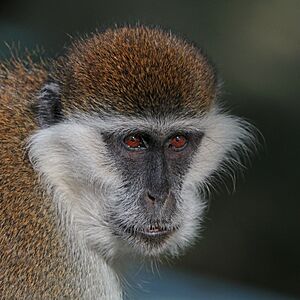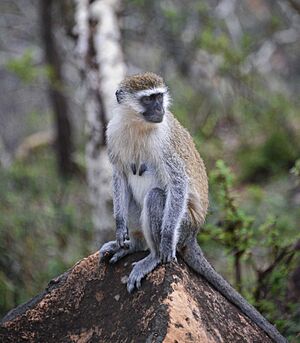Grivet facts for kids
Quick facts for kids Grivet |
|
|---|---|
 |
|
| Amora Gedel Park, Awasa, Ethiopia | |
| Conservation status | |
| Scientific classification | |
| Genus: |
Chlorocebus
|
| Species: |
aethiops
|
 |
|
| Grivet range | |

The grivet (Chlorocebus aethiops) is a type of Old World monkey. It has long, white hair on the sides of its face, like whiskers. These monkeys live only in parts of Africa, including Ethiopia, Sudan, Djibouti, and Eritrea. In some areas, the grivet lives near its close relatives, like the vervet monkey. Sometimes, they can even have babies together. This can be a problem for the rare Bale Mountains vervet. Luckily, the grivet is quite common and is not considered endangered.
Contents
Physical Features of the Grivet
The grivet has black skin on its face, hands, and feet. It has a white line above its eyes and long, white whiskers on its cheeks. The fur on its back is olive-colored, while its belly is white. The skin on its stomach can look a bit blue. Its fur feels rough.
Male grivets are usually about 49 centimeters (19 inches) long from head to body. Females are a bit smaller, around 43 centimeters (17 inches). Their tails are long, about 30 to 50 centimeters (12 to 20 inches). Grivets weigh between 3.4 and 8 kilograms (7.5 to 17.6 pounds), with females being lighter.
Where Grivets Live
Grivets mostly live in savanna woodlands. You can find them in Sudan (east of the White Nile), Eritrea, and Ethiopia (east to the Rift Valley). They also live in Djibouti. Grivets need to live near water, especially when it's dry. They are good at living in different kinds of places.
Local Names for the Grivet
In the Tigrinya language, the grivet is called ወዓግ (wi’ag).
Grivet Behavior
Grivets are most active in the morning and early evening. They spend most of the day on the ground looking for food. At night, they sleep in trees to stay safe. Grivets spend a lot of time grooming each other, playing, climbing, and play-fighting. These activities help them learn important skills for survival.
Grivets are omnivores, which means they eat both plants and animals. They mostly eat fruits and vegetables. They also eat small mammals, insects, and birds. Sometimes, they even look for human food. They must drink water every day, especially during dry seasons.
Grivets live in groups that can have anywhere from 5 to over 70 monkeys. These groups often have many males. To show who is in charge, a dominant male will stiffen his tail, point it straight up, and walk past other males. Grivets usually walk on all four legs. But if they need to carry something with both hands, they can walk and run comfortably on two legs.
Reproduction and Life Cycle
Female grivets usually have only a few mates, while males might have several. A mother grivet typically gives birth to one baby at a time. Pregnancy lasts about 2 to 3 months. When a baby is born, the mother cleans it and bites off the umbilical cord.
Young grivets are born with pink faces and black hair. It takes about two months for them to get their adult fur. For the first few months, the baby stays very close to its mother. After about 6 months, the baby stops drinking its mother's milk. Grivets can live for about 13 years.
Conservation of Grivets
Sometimes, grivets are hunted for their meat. This happens for both selling and for people to eat themselves. Even though grivets are not endangered, their homes (forests) are sometimes destroyed, which can be a threat to them. Large snakes, leopards, humans, and sometimes baboons hunt grivets.
Grivets and Humans Through History
The grivet is one of five types of monkeys known to have been kept in ancient Egypt. The others were the hamadryas baboon, the olive baboon, the patas monkey, and the barbary macaque. Grivets were brought to Egypt from a place called the Land of Punt. We know this from old paintings and stories, like the Tale of the Shipwrecked Sailor. Sometimes, grivets were even traded as far away as Assyria. They don't appear as often in Egyptian art as baboons, and they don't seem to have had individual names like some baboons did.
In Egyptian tombs, grivets are shown as pets, sometimes on leashes. Small statues of grivets have been found in ancient temples. These might have been gifts to the baboon god. In some stories, a grivet shooting a bow was a symbol of the god Atum. In a place called Deltaic Babylon, a grivet was even seen as the town god, with a statue in the temple.
Since the 1960s, grivets have been used in some scientific studies, including for testing vaccines and human cosmetics.

